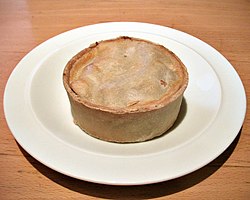Scotch pie: Difference between revisions
No edit summary |
Panama1958 (talk | contribs) m Removed reference to being served in foil trays as this is not at all common |
||
| Line 22: | Line 22: | ||
The traditional filling of [[mutton]] is often highly spiced with [[black pepper|pepper]] and other ingredients and is placed inside a shell of [[hot water crust pastry]]. An individual piemaker's precise recipe, including the types and quantities of spice used, is usually kept a close secret, for fear of imitations. It is baked in a round, straight-sided tin, about 8 cm in diameter and 4 cm high, and the top "crust" (which is soft) is placed about 1 cm lower than the rim to make a space for adding accompaniments such as mashed [[potato]]es, [[baked beans]], [[brown sauce]], [[gravy]] or an [[Egg (food)|egg]]. |
The traditional filling of [[mutton]] is often highly spiced with [[black pepper|pepper]] and other ingredients and is placed inside a shell of [[hot water crust pastry]]. An individual piemaker's precise recipe, including the types and quantities of spice used, is usually kept a close secret, for fear of imitations. It is baked in a round, straight-sided tin, about 8 cm in diameter and 4 cm high, and the top "crust" (which is soft) is placed about 1 cm lower than the rim to make a space for adding accompaniments such as mashed [[potato]]es, [[baked beans]], [[brown sauce]], [[gravy]] or an [[Egg (food)|egg]]. |
||
Scotch pies are often served hot by take-away [[restaurant]]s and bakeries, and at outdoor events. The hard crust of the pie enables it to be eaten by hand with no wrapping |
Scotch pies are often served hot by take-away [[restaurant]]s and bakeries, and at outdoor events. The hard crust of the pie enables it to be eaten by hand with no wrapping. Typically there is a round hole of about 7.5mm in the centre of the top crust, which has given rise to the colloquial name 'chimney pie' in Scotland. |
||
Every year, the Scotch Pie Club holds the World Scotch Pie Championship. [[Butcher]]s and [[baker]]s enter their pies into this competition, and the maker of the pie judged tastiest by a panel of judges is awarded the title of World Scotch Pie Champion. |
Every year, the Scotch Pie Club holds the World Scotch Pie Championship. [[Butcher]]s and [[baker]]s enter their pies into this competition, and the maker of the pie judged tastiest by a panel of judges is awarded the title of World Scotch Pie Champion. |
||
Revision as of 16:56, 12 February 2014
This article needs additional citations for verification. (November 2012) |
 | |
| Alternative names | Shell pie, mince pie, football pie |
|---|---|
| Type | Meat pie |
| Place of origin | United Kingdom |
| Region or state | Scotland |
| Serving temperature | Hot |
| Main ingredients | Mutton or other meat, hot water crust pastry |

A Scotch pie is a small, double-crust meat pie filled with minced mutton or other meat. It may also be known as a shell pie or a mince pie (although the latter term is ambiguous) to differentiate it from other varieties of savoury pie, such as the steak pie, steak and kidney pie, steak-and-tattie (potato) pie, and so forth. The Scotch pie is believed to originate in Scotland, but can be found in other parts of the United Kingdom, and is widely sold all over Canada. They are often sold alongside other types of hot food in football grounds, traditionally accompanied by a drink of Bovril, resulting in the occasional reference to football pies.
The traditional filling of mutton is often highly spiced with pepper and other ingredients and is placed inside a shell of hot water crust pastry. An individual piemaker's precise recipe, including the types and quantities of spice used, is usually kept a close secret, for fear of imitations. It is baked in a round, straight-sided tin, about 8 cm in diameter and 4 cm high, and the top "crust" (which is soft) is placed about 1 cm lower than the rim to make a space for adding accompaniments such as mashed potatoes, baked beans, brown sauce, gravy or an egg.
Scotch pies are often served hot by take-away restaurants and bakeries, and at outdoor events. The hard crust of the pie enables it to be eaten by hand with no wrapping. Typically there is a round hole of about 7.5mm in the centre of the top crust, which has given rise to the colloquial name 'chimney pie' in Scotland.
Every year, the Scotch Pie Club holds the World Scotch Pie Championship. Butchers and bakers enter their pies into this competition, and the maker of the pie judged tastiest by a panel of judges is awarded the title of World Scotch Pie Champion.
See also
References
- "Aiming high for the best Scotch pie". BBC News Online. November 18, 2004.
- "World Scotch Pie champion named". BBC News Online. November 30, 2004.
